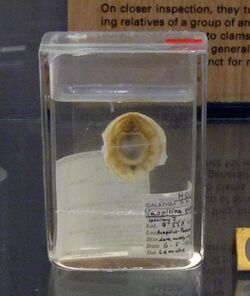Biology:Neopilina galatheae
| Neopilina galatheae | |
|---|---|

| |
| The holotype of N. galatheae at the Zoological Museum, Copenhagen | |
| Scientific classification | |
| Domain: | Eukaryota |
| Kingdom: | Animalia |
| Phylum: | Mollusca |
| Class: | Monoplacophora |
| Order: | Neopilinida |
| Family: | Neopilinidae |
| Genus: | Neopilina |
| Species: | N. galatheae
|
| Binomial name | |
| Neopilina galatheae Lemche, 1957
| |
Neopilina galatheae is a species of monoplacophoran, a superficially limpet-like marine mollusc.[1] Its name means new Pilina (after Pilina, an extinct monoplacophoran species that lived about 400 million years ago). It lives in depths of 5000 meters and the shell is 3 centimeters in length in adults. [2]
The species was discovered off the Pacific coast of Costa Rica in the 1950s, where 10 specimens were collected. Later, additional specimens have been collected off the coast of Chile and off Cabo San Lucas, Baja California, Mexico.[3] The species was the first living monoplacophoran to be discovered; previously the taxon had been considered extinct for 375 million years. Shortly after its description, the discovery of the species was described as "a zoological discovery of the first order".[4]
References
- ↑ MolluscaBase (2020). "Neopilina galatheae". MolluscaBase. World Register of Marine Species. http://www.marinespecies.org/aphia.php?p=taxdetails&id=343689.
- ↑ Pechenik, Jan A. (2015). "Chapter 12: The Molluscs". in Peden, Jane. Biology of the Invertebrates (7 ed.). McGraw-Hill Education. ISBN 978-0073524184.
- ↑ Schwabe, Enrico (2008). A summary of reports of abyssal and hadal Monoplacophora and Polyplacophora (Mollusca). In: Martínez Arbizu, P. & Brix, S. (Eds) (2008) Bringing Light into Deep-sea Biodiversity. Zootaxa, 1866, 1–574.
- ↑ Yonge, C. M. (1957). "Reflexions on the monoplacophoran, Neopilina galatheae Lemche". Nature 179 (4561): 672–673. doi:10.1038/179672a0. https://www.nature.com/articles/179672a0.pdf?origin=ppub.
Wikidata ☰ Q1977589 entry
 |

